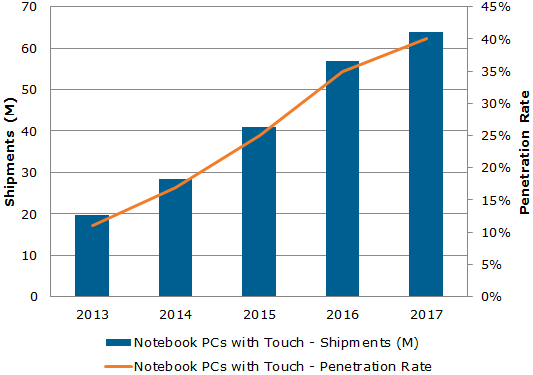Touchscreen notebooks increase in popularity -- but why? Why? WHY?!

We're all used to getting touchy-feely with our phones and tablets, but it's only in the past few months that touchscreen laptops have really gained any ground. A report by NPD DisplaySearch states that by the end of 2013, touchscreen devices will account for 11 percent of all notebook shipments -- that's around 19.8 million notebooks with touchscreens -- and there has been a steady increase in market share since the beginning of the year.
Richard Shim, senior analyst at NPD DisplaySearch explains that "Premium pricing and a lack of compelling uses for touch screens on notebooks continue to hinder adoption", but goes on to say that "as touch interfaces become increasingly common across all mobile devices, it is just a matter of time before the technology also becomes more prevalent in notebooks".
But pricing is becoming much less of an issue. Acer's budget touchscreen C720P Chromebook brings a touch-sensitive screen to a wider audience, though I can't help but wonder whether it’s a feature that will actually be used. In my mind, touchscreen is a gimmick. I'm not just postulating here, rather talking from personal experience.
The idea of touchscreen is appealing. When using a phone or tablet -- unless you're one of the few remaining BlackBerry users -- everything is achieved via touch: web browsing, scrolling through pictures, composing emails, playing games, and much more. It makes sense to add the same option to a regular computer right? It would make life so much easier! But would it... or indeed does it?
I use a Surface Pro day in, day out. It has a great touchscreen and Windows 8.1 is touch-friendly. But I never use the touchscreen when the Surface is in laptop mode. On the odd occasion I whip off the keyboard and use the Surface as a tablet, I'll give it a good touching up, but once that keyboard is snapped into place, it's a regular laptop that may as well have a regular screen. I also have a touchscreen Acer laptop. Touch is never used.
Why? It is just awkward to reach over the keyboard to tap or slide on the screen. Why move my entire arm when a couple of fingers can achieve the same by moving a couple of centimeters on the trackpad? You could argue that not many apps have been designed to take full advantage of touchscreen on the desktop (or laptop), but that doesn’t get over the problem that with a laptop, it is almost always more effort to use a touchscreen than not.
What we tend to use laptops for -- browsing the web, typing email, writing documents -- aren't activities that really lend themselves to touchscreen operation. On convertible devices such as Lenovo's Yoga, I can see the point. Fold the keyboard out of the way to create a tablet or screen stand and you need a way to interact with your video app, web browser, or whatever else you are doing. But on a regular laptop I would argue that touch support is completely pointless.
The gradual increase to 11 percent market share for touchscreen laptops, from just 7 percent in the first quarter of 2013, shows touch friendly devices are set to continue to climb -- all the way to 40 percent by 2017 if NPD DisplaySearch's figures are to be believed. Prices will come down across the board, but touchscreen laptops will, inevitably, remain more expensive than regular laptops. It sounds like a nice feature, but once the honeymoon period is over, how many people will continue to interact with their laptop by prodding at the screen? It seems like something that will be forgotten about like a discarded toy a couple of days after Christmas.

Touchscreens have their place for sure -- I just don’t think laptops are the best use of this particular technology.
What do you think? Do you have a touchscreen laptop or monitor that you're happy with, or are you holding off?
Photo credit: Brian A Jackson/Shutterstock
